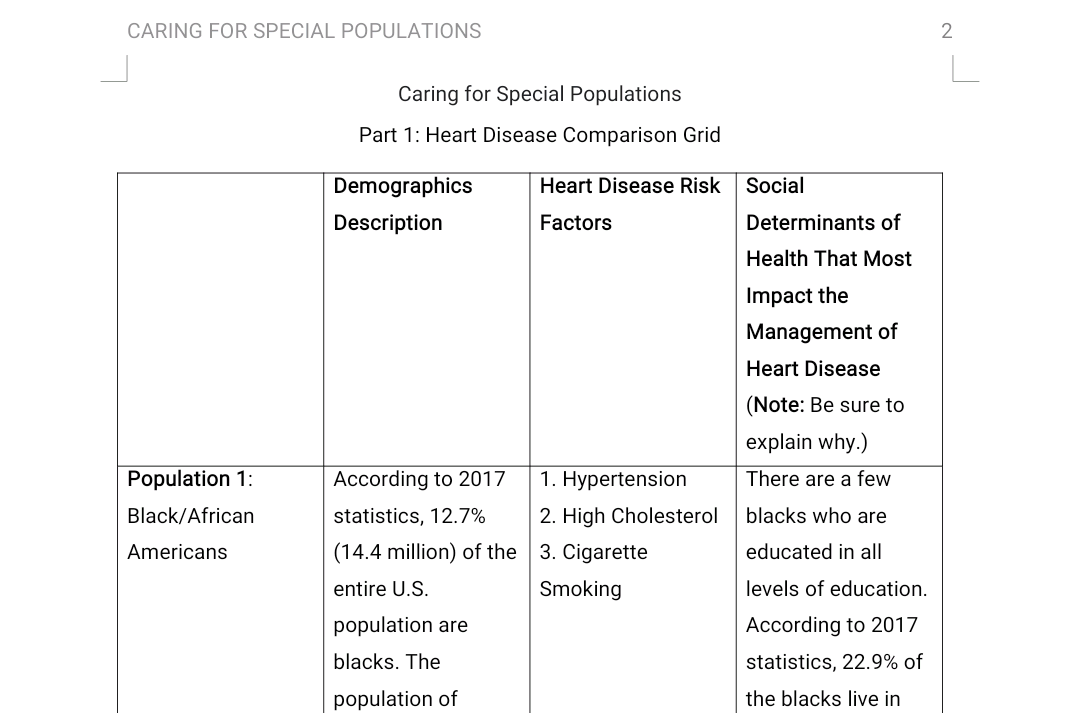
Consider how access to healthcare, Medicare, or Medicaid programs may impact heart disease and health outcomes for these populations.
Caring for Special Populations
Learning Resources
REQUIRED READINGS
Penner, S. J. (2017). Economics and financial management for nurses and nurse leaders (3rd ed.). New York, NY: Springer Publishing.
Chapter 2, “Health Insurance and Reimbursement” (pp. 27-60)
Barnett, J. C., & Vornovitsky, M. S. (2016). Health insurance coverage in the United States: 2015: Current population reports. Retrieved from https://www.census.gov/content/dam/Census/library/publications/2016/demo/p60-257.pdf
Glatter, R. (2017). In 3 states, if Anthem thinks you shouldn’t have gone to ER, it won’t pay. Retrieved from https://www.forbes.com/sites/robertglatter/2017/10/16/anthem-at-odds-with-your-decision-to-visit-the-er-and-refusing-to-pay-in-certain-states/#78f08a254356
Keith, K. (2018). Litigation update: Challenges to Kentucky’s Medicaid waiver, cost-sharing reduction, and risk corridors. Retrieved from https://www.healthaffairs.org/do/10.1377/hblog20180125.91141/full/
U.S. Department of Health and Human Services, Office of Minority Health. (2016). Minority population profiles. Retrieved from https://minorityhealth.hhs.gov/omh/browse.aspx?lvl=2&lvlid=26
Assignment: Caring for Special Populations
Managing the health of special populations can be a challenge with the various economic forces at work. This is especially true in the case of supply and demand of healthcare services. This week, you are going to examine a special population of people, those with cardiac disease, and look at how health insurance affects the health outcomes of this population. Do people with poor insurance or no insurance manage chronic illness less effectively than those with insurance? Does geography or education affect the health outcomes of cardiac patients?
In this Assignment, you will look through the lens of social determinants of health, focusing on three populations to see if we can draw any conclusions regarding the management of the chronic illness of cardiac disease.
To Prepare:
Access the U.S. Department of Health and Human Services Office of Minority Health (2016) provided in this week’s Learning Resources.
Select three of the five populations provided in the database, and compare profiles for these three populations.
Reflect on how the three populations you selected might approach the management of heart disease.
Reflect on heart disease risk factors for the three populations you selected.
Consider how access to healthcare, Medicare, or Medicaid programs may impact heart disease and health outcomes for these populations.
The Assignment: (Matrix Template; 2-page paper)
Part 1: Heart Disease Comparison Grid
Download the Week 2 Matrix Template document from the Learning Resources area.
Complete the template by addressing the following:
Describe the demographics for each of the three populations you selected. Be specific and provide examples.
Explain at least three heart disease risk factors that may impact each of the three populations you selected. Be specific, and provide examples.
Describe which social determinants of health most impact each of the three populations you selected for the management of heart disease, and explain why. Be specific, and provide examples.
Part 2: Narrative Summary
In a 2-page narrative summary, address the following:
Explain what conclusions you might draw, regarding the management of heart disease and chronic illnesses for the populations you selected.
Explain how healthcare access and health insurance programs (including Medicare and Medicaid) might help to address the heart disease risk factors and the social determinants of health for each of the populations you selected.
BY DAY 7
Submit your Matrix Template and Narrative Summary.
Answer preview…………

Apa 895 words